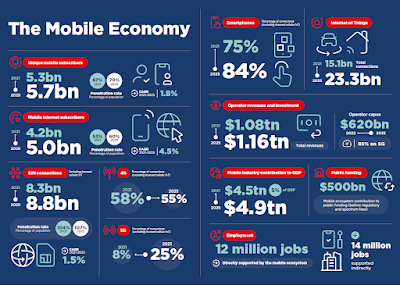Highlighting the mobile industry's instrumental role in extending connectivity to people worldwide, the report, which is authored by GSMA Intelligence, the research and consulting arm of the GSMA, a UK-based organization representing the interests of mobile operators worldwide, notes that "Operators' investments in network infrastructure over the last decade have helped to shrink the coverage gap for mobile broadband networks from a third of the global population to just 6%." The 'coverage gap' refers to those living outside of areas covered by mobile broadband networks.
"But although the industry continues to invest in innovative solutions and partnerships to extend connectivity to still underserved and far-flung communities," the report points out that "the adoption of mobile internet services has not kept pace with the expansion of network coverage. This has resulted in a significant usage gap. In 2021, the usage gap stood at 3.2 billion people, or 41% of the global population." The 'usage gap' refers to those who live within areas covered by mobile broadband networks but do not yet subscribe to mobile broadband services.
- By the end of 2025, 5G will account for around a quarter of total mobile connections, and more than two in five people worldwide will live within reach of a 5G network.
- In 2021, mobile technologies and services generated $4.5 trillion of economic value, equating to 5% of global GDP. The report predicts that this will grow to $5 trillion in 2025.
- As 5G adoption accelerates in leading markets such as China, South Korea, and the US, 4G begins to decline. Globally, 4G adoption will account for 55% of total connections by 2025, down from a peak of 58% in 2021.
- But 4G still has room to grow in most developing markets. For example, in Sub-Saharan Africa, 4G adoption is below a fifth of total connections.
- 3% billion people subscribed to mobile services, representing 67% of the global population, by the end of 2021.
- In a growing number of markets, most adults now own a mobile phone, meaning that future growth will come from younger populations taking out a mobile subscription for the first time.
With respect to the achieving the United Nations' Sustainable Development Goals (SDGs) before the deadline in 2030, the report says "Mobile technology will play a central role in those efforts, from improving access to education and healthcare to addressing issues with poverty and inequality." The report also outlines a set of policy recommendations for achieving a resilient post-pandemic recovery. This involves investing in digital skills training, utilizing public funds for connectivity, adopting a balanced approach to collecting revenues through taxes and fees in the mobile sector, and prioritizing digital transformation in government services.
Returning to the topic of the usage gap, the reports explains:
The reasons for the usage gap are multifaceted and vary by region, but they generally relate to a lack of affordability, relevance, knowledge and skills, in addition to safety and security concerns. Furthermore, the barriers to mobile internet adoption are particularly acute among certain segments of the population, including women, the elderly, those in rural areas and persons with disabilities – or a combination thereof. Addressing the usage gap for these key groups will extend the benefits of the internet and digital technology to more people in society, and will require concerted efforts by a broad range of stakeholders working together with mobile operators and other ecosystem players, such as device manufacturers and digital content creators.
 |
| Infographic: GSMA |
What do you think of the report's findings? What solutions do you recommend for bridging the usage gap?

No comments:
Post a Comment